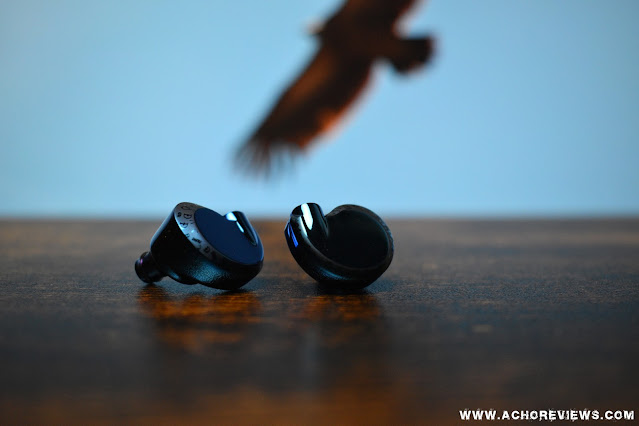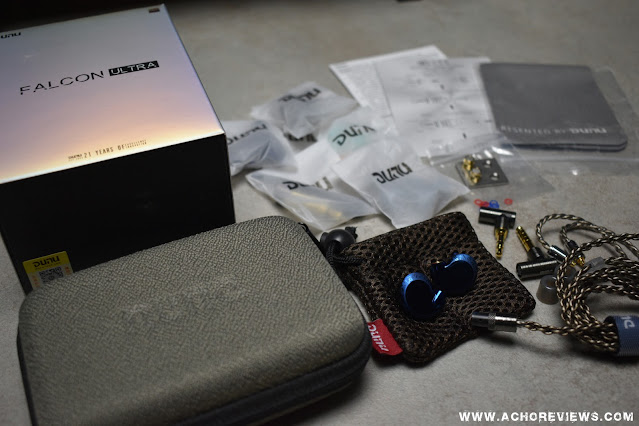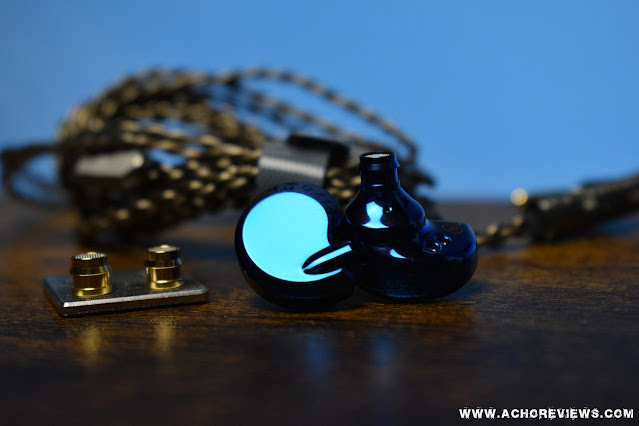- Get link
- X
- Other Apps
English | Español
TLDR version on YouTube: TDLR - Dunu Falcon Ultra
The Dunu Falcon Ultra have been sent to me as part of a tour organized by Dunu on Head-Fi. There have been no requests or comments made by Dunu and I will do my usual best to be as unbiased as possible.
The official page for the Falcon Ultra can be found here: https://www.dunu-topsound.com/copy-of-falcon-pro
As always, this is a non-affiliate link.
To avoid being repetitive in my reviews, you can find all the info about how I create the reviews, equipment used, how I receive the products and how to interpret my reviews by visiting: About my reviews
Intro…
This is the fifth set of Dunu IEMs that I have reviewed and each of them has their own twist to the way they present sound. The Falcon Ultra is the one that has the most focus on bass, specifically midbass, out of the models I have tried and, while I am not someone who likes an overly emphasized midbass, these IEMs have a lot going for them.
Priced at just under $240, at the time of putting this review together, these are part of the Eclipse range, together with the Luna, Zen Pro and Falcon Pro (none of which I have tried). They feature a single 10.7mm dynamic driver, with what they claim to be an new lithium magnesium dome structure and fully independent soft suspension surround, together with an external ring-type magnetic assembly which is said to be close to the Zen Pro as far as magnetic flux.
There are plenty of other fancy things going on with the technical design of these IEMs but, as usual, I will look at them in the simplest of fashions, giving my opinion on how they are to a run of the mill music listener.
Presentation…
These IEMs retail for over 200€, so we should expect some decent packaging and accessories, although that isn’t always the case as we have seen with many models in the past. In this case, however, I think that they have done a more than satisfactory job.
I must remind you that this is a tour unit, so I am not the first one to open it. Therefore, it is possible that things are not in their correct spot as they would be when packaged, or things may even be missing, although I don’t think it is the case here.
The outer packaging is simple. A silver outer sleeve with just plain text is what we get. There are specs listed on the back but there really isn’t anything that draws our attention. Removing the outer sleeve reveals a simple black box that is even less “special” than the outer sleeve.
Inside the box things start to get a little more interesting. The first thing we find is a rather large and elegant storage/transport case. Dunu usually include cases that are a little different to the rest of brands but I have to say that I think this is my favourite out of all of them so far.
Inside the case are the IEMs, with individual plastic zip lock bags covering them (thanks to the previous tour members for doing their best to look after this delicate finish), the cable which is the Q-Lock Lite Modular version, the additional connector for the cable (both 3.5 and 4.4 are included) and an extra set of nozzles (more on that in a moment).
Then, underneath the case, we find the accessories box, which contains even more stuff. There is a dual pocket small bag to protect the IEMs, a cleaning cloth, a 3.5mm to 6.35mm adapter, a cleaning tool, replacement o-rings and 3 sizes of 3 different types of tips (so 9 pairs in total). I actually think that there may be another 3 sets in the retail package, as the Dunu S&S tips are installed on the IEMs but there were no extra sets included in the accessories box.
So, as I said, I think it is fair to say that Dunu have done a very respectable job with the contents of this set.
Build and aesthetics…
The great thing about the aesthetics of these IEMs is also the terrible thing about the aesthetics of these IEMs! They are a beautiful shiny blue, with tiny engravings (D and Dunu) on the surround, yet they are both finger magnets and very very easily scratched. They are also pretty difficult to photograph as you need to try and get the light reflecting just right and each time you move them, you need to clean them.
If you want these to stay looking great, then I think that the dual pocket bag and the cleaning cloth are going to need to become part of your main EDC. However, I really do think that the aesthetics are worth it (even if I can’t see them when they are in my ears). The most beautiful set of IEMs ever to come across my desk is from Dunu (Vulkan) and although these are not quite as unique, they still rank very highly in my opinion.
They are a little on the heavy side, weighing in at 10 grams each ear (plus the weight of the hanging cable), yet the ergonomics go a long way to counteracting that weight. I find the very comfortable and do not notice the additional weight when they are in the ears at all.
As mentioned, the included cable is the Q-Lock Lite with swappable terminations, including both the 4.4mm balanced and 3.5mm unbalanced connectors. This is the same cable that I received with another model of Dunu (I can’t remember which at this moment) and I am a fan. It is not overly thick and while it isn’t the softest of cables to the touch, it doesn’t have a mind of its own. It is said to be a 4 strand high purity silver plated single crystal copper Litz cable but, as you probably know by me, if a cable is well made, comfortable and does its job well, then I like it. And this one does all 3.
Sound…
All tracks mentioned are clickable links that allow you to open the reference track in the streaming service of your choice (YouTube, Tidal, Qobuz, Spotify, etc.)
Before getting into the sound, I think I am going to go a little against the grain here. As mentioned a moment ago, there are two nozzles included with the Falcon Ultra, one gold and one blue, that makes quite a noticeable change from the upper mids upwards.
Here are the differences between the two, with my usual preference target for reference:
I say I am going to go against the grain here as I think that the majority of users will probably prefer the gold nozzle, at least those that I have spoken to do. The gold nozzle reduces the heat a little in those upper mids and make things a little less harsh, although they are not exactly harsh anyway but just to try and describe it in a way that is easy to understand (that's how I try to do things in my reviews, although it doesn’t always work out 😉 )
Now, I would probably opt for the gold nozzles also, if it wasn’t for one thing, the midbass. I have said many times that I am not someone who favours excessive midbass. If the quality of the midbass is good (which it is here, but I’ll get there in a moment), then I can enjoy it but as soon as the midbass lacks definition and clarity, then I find it very fatiguing, even causing me a headache. In this case, as I just said, the midbass is good, great even, but I still prefer a little less focus on that frequency range and the blue nozzles, with their slight elevation in the upper mids, does take the focus away from the midbass slightly. There are times when certain vocals can become a little thin or harsh but that is much more dependent on the recording than the actual voice itself. In those cases, then yes, I found myself preferring the gold nozzles, but for the majority of the music I enjoy, I found myself drawn to the blue nozzles more.
Anyway, enough chit chat and on with how these perform, using the blue nozzles and the included clear tips.
Starting off with the subbass, you can guess which track I am going to refer to… yes, “Chameleon”. Subbass is clean and defined, without being overpowering. While the additional midbass presence does put the focus slightly more on that range than the subbass per se, it is still a subbass that I find to be impressive, dealing well with the excessiveness that is “Chameleon”.
“Royals” by Lorde also demonstrates that subbass is of a good quality with good detail (as much detail we can expect from the subbass range that is). The touch of “dirt” that is present in the recording of this track is easily identified and I cannot find any reason to complain about the subbass on the Falcon Ultra.
As we move into the midbass, here is where I am more delicate, as I mentioned before. Yet there is no reason for me to be negative here either. Although the midbass is more present than I would prefer, there is absolutely no sensation of bloat or loss of control. My midbass fatigue test that is “Crazy” gives me no fatigue at all, showing that the midbass is clear, well defined and basically just great quality.
In the midbass is where I most appreciate the blue nozzles, not because the midbass becomes fatiguing with the gold ones, just because there isn’t as much of an emphasis on this range with them. Even with the gold nozzles, “Crazy” still doesn’t become fatiguing, there is just too much midbass focus for me, so it is about a personal tuning taste rather than any specific issue with the range.
One thing to note with the change of nozzles is that vocals will seem to be a little warmer and have some more body to them when opting for the gold option. With the blue, it can seem that the center of vocals can be a little less “lush”, yet this is only really an issue with very specific vocals on very specific tracks.
In the upper mids is where the biggest difference resides, although I keep saying that it is the effect on the midbass that I suffer with. Even with the blue nozzles, which are slightly harsher in the upper mids, vocals are still not harsh or overly shouty. In fact, they are much better than many many other sets that have less presence in these areas. Even with “Hello” by Adele, a track that easily shows compression on revealing sets, the vocals don’t become uncomfortable, they just sound, well, compressed.
“Don’t You Worry Child” is a track that I like to use for testing harshness, due to the fact that Beth’s voice can become very uncomfortable with excessive upper mids and lower treble (she has a very harsh voice in this recording). Here you can notice the harshness to her voice but, once again, it doesn’t become uncomfortable. At least no more than usual.
Sibilance is not really reduced but it is not boosted nor uncomfortable either. “Hope Is A Dangerous Thing” is a track that can be quite painful in the opening lines and the Falcon Ultra keeps it in check without dimming it. My usual non-scientific scale of -12 to +12 (0 being neutral) with the vocals of Patricia Barber in “Code Cool” would place her between -1 and -2, a nice balance.
Treble extension is decent, with a nice sensation of air yet not peaky nor overly boosted to give a false sensation of detail. It maybe doesn’t extend as far as other hybrid sets but it doesn’t give me a sensation of being rolled off at all (at least within my personal hearing capabilities).
Speaking of detail, the Falcon Ultra is impressive here also. It might not be the most detailed set I have ever heard yet it does a great job of making all the details available without pushing them at you with brute force. Again, it is a very respectable set of IEMs that performs very well without overdoing it.
Soundstage is probably just north of average. It’s not huge but at no point does it feel congested or claustrophobic. It is very rare that I find IEMs to have huge soundstages anyway and I have to say that the Falcon Ultra gives me enough in this regard.
Conclusion…
I cannot do anything but praise the Falcon Ultra. It is an IEM that performs very well at a very reasonable price. Obviously reasonable depends on the budget of each person but at a similar price point we have the Kiwi Ears Quintet, actually a little more expensive, which I said was the best thing under 500€ that I reviewed last year. Well, I would say that the Quintet is maybe more impressive upon first listen but I really think that the Falcon Ultra, with a lot less drivers, can easily compete against the Quintet. For those who will ask Quintet vs Falcon Ultra (I guarantee that the YouTube video comments will see this question asked), I have to say, I really don’t know. I am a big fan of the Quintet yet the Falcon Ultra is right up there with it and with a simple single dynamic driver, something that I am also a fan of.
Speaking of single dynamic drivers, I also really enjoy the Sennheiser IE600. I honestly think that the Falcon Ultra would maybe steal the recommendation here as it performs on a similar level, maybe not quite at the same level but close, at just over a third of the price.
All I can say is that the Dunu Falcon Ultra is a very good set of IEMs that I have no doubt is worth its asking price.
All FR measurements of IEMs can be viewed and compared on achoreviews.squig.link
All isolation measurements of IEMs can be found on achoreviews.squig.link/isolation
To comment or contact, visit any of the following social media platforms:







